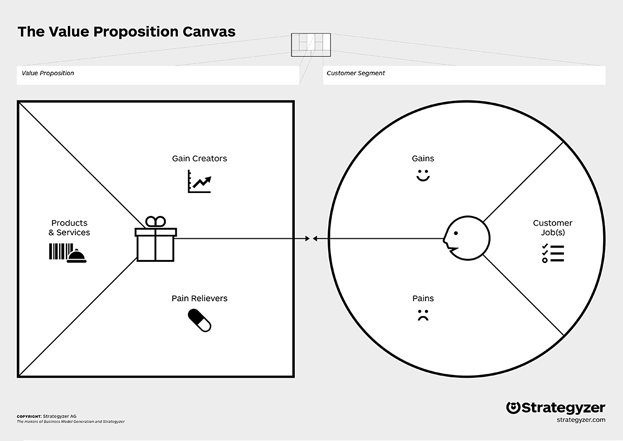Value Proposition Canvas - Part One
You can download a template for free at strategyzer.com
Business Modelling is based on empathy.
If we want to be able to design products and services that delight our customers, then we need to understand those customers inside and out.
This is the hardest part of business modelling, and the most misunderstood part of the Business Model Canvas.
That’s why Strategyzer developed a second tool, which goes into more detail and helps create clear, compelling value propositions that customers love.
To use the Value Proposition Canvas, we first need to understand our customer and their “Jobs To Be Done”.
These Jobs are the things that our customer feels compelled to do.
The things that are on their plate - the forces that drive their decision making.
To avoid this being vague and generic, we can break these down into three categories:
Functional Jobs – The practical things that need to get done.
Going to work, eating nutritious food, taking the kids to school, fixing a broken window, booking a table for dinner.
Social Jobs – The role you play in your social group, and the ways you’d like to be perceived. Being a responsible parent, being a good boyfriend, looking professional and successful, fitting in with your tribe.
Emotional Jobs – The way you want to feel.
Being competent in your career, the need to treat yourself, avoiding anxiety, not wanting to have to think about logistics, the desire to experience joy, the feeling of success.
This is more art than science, and draws heavily from consumer psychology and behavioural economics.
We’re not dealing with rational, robotic customers, instead this is about the weird ways our customers make and justify their decisions.
We’d like to think that all of our decisions are functional – that we buy things that are practical, economical and high quality.
The reality is, we don’t focus on the functional, we focus on how the functional benefits make us feel.
To understand this further, let’s try out an example from our own lives:
When you last went to buy a car, what were you looking for?
Functional Considerations
Number of seats – because I have 0/2/5 kids
Boot space – it needs to be able to fit my two dogs
Pulling power – my job requires me to transport large boxes
Ease of parking – I work in the city and parking sucks
Running costs – I don’t want to spend too much each week
Aux port – I want to connect my phone
Budget – I can spend up to $15,000
Social Considerations
Wanting to look professional – I can’t show up to work in a run-down car
Wanting to look successful – It needs to look like I've made money
Hoping to attract “special friends” – It should impress my passengers
Fitting in with my colleagues – I don’t want to seem different
Masculinity/Femininity – I don’t want a “girly car” or “hoon car”
Joining in – I want to be able to go 4WD’ing with my friends on weekends
Environmental responsibility – I want to show that I’m socially conscious
Personal style – It should match my general lifestyle
Family connections – My sister is moving overseas and buying her car will help her out
Emotional Considerations
The wind through your hair – I want to enjoy my driving
Love of a brand – I have a Holden tattoo and will love them until I die
Childhood dreams – I’ve always wanted a red convertible
Exhilaration – Hearing a roar when I accelerate
Removing stress – Parallel parking always makes me anxious
Dependability – I don’t want surprise expenses
Environmental responsibility (again) – It should match my worldviews on fossil fuels
These are all good things to think about, but not everyone thinks about all of them.
In fact, for each customer segment, there will be a few standout jobs that really shape their decision making.
We call these Gains and Pains:
Gains are the positive states of being our customer is searching for
Pains are the negative states of being our customer is hoping to avoid
Sometimes the same job can be framed both ways:
“7 airbags is a nice bonus” vs “I’m not comfortable putting my baby in a car without 7 airbags”
“I’d love to save money on fuel if possible” vs “My current car costs $1,000 to service and I hate it”
You get to choose whichever feels most appropriate for your customer.
Using the jobs we listed earlier, we can start to frame them as the Gains and Pains that shape our customer’s decisions.
Gains
“Tesla’s are so cool; the model S is my dream car”
“If I bought a 4WD, I would spend more time going camping”
“My clients would be impressed if I arrived to their office in a sleek, modern car”
“I’d like something that will have a high re-sale value, because I’ll be selling it in two years’ time”
“We’d like a car that has seven seats, we might be having more kids in the future”
“I want something with a great sound system and lots of bass, I tend to sing when driving to work”
Pains
“I spend far too much on fuel; I want something more efficient”
“My friends tease me about my old/ugly/rev-head car, and I’m embarrassed”
“My car is really hard to park; I want something that makes parking easier”
“I’m worried that my current car isn’t safe, and I get nervous whenever I drive it”
“Our family car is cramped, and our kids hate going on holidays when they’re squished in the back”
Ranking Customer Jobs
It’s important to understand not just the Pains and Gains, but how they are ranked.
Yes, we’d all love a perfect car, but most of us can’t/won’t pay a ridiculous amount for one.
This is where the tradeoffs come in:
Trading cool for practical
Trading low upfront prices for low running costs
Trading spaciousness for manoeuvrability
Trading comfortable for environmental
The easiest starting point is to think of the stereotypes – the carpenters, soccer mums, mid-life crisis splurges, real estate agents, eco warriors, etc.
It’s easy to mock these icons, but the truth is you and I are probably equally strange in our decision making.
Everyone likes to think they’re sensible and rational, but that can’t be the case.
There’s no judgement here, just a neat map.
The Value Proposition Canvas is a great way of capturing the forces that influence and shape our decision making.
That’s so important, because there are new customer archetypes forming all the time.
By understanding our customer, by empathising with their jobs, their frustrations and their aspirations, we can keep designing things they’ll love, even if they haven’t yet asked for them.
Up next in Part Two we'll look at Gain Creators and Pain Relievers, where companies get to pitch their most compelling offers…
For more of the Value Propositions Case Studies series;
Part One featuring Louis Vuitton, AFL, Uber and TOMS
Part Two featuring Nespresso, Heineken, and Shoes of Prey
Part Three featuring a variety of Men’s Watches and Chocolate brands
Part Four featuring the classic iPod ads, Whiskey, Hardware, Butter and Barossa Tourism
Being The Best explores how companies frame themselves as industry leaders
Being The Cheapest covers strategies for demonstrating value for money
Social Proof examines how brands make themselves look popular and trustworthy
Cologne looks at how intangible gains are conveyed through imagery and design
Bottled Water compares ten brands selling the same product in different ways
If you’re crafting Value Propositions, you’ll love my free Value Propositions eBook, full of tips for designing and testing compelling Value Propositions that will delight your customers.














